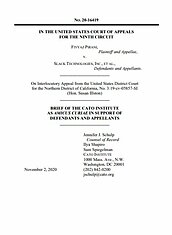Learn more about Cato’s Amicus Briefs Program.
These days, questionable shareholder lawsuits are a dime a dozen. Pirani v. Slack appeared at first blush to be just the latest example. That is, until the Northern District of California decided to undo one of the longest standing precedents in federal securities caselaw. For decades, courts in every circuit have held firm to Judge Henry Friendly’s ruling in Barnes v. Osofsky (1967) that in order to sue under Section 11 of the Securities Act of 1933 for misstatements or omissions in a registration statement, a claimant must be able to “trace” their shares to the allegedly faulty statement. But, the district court jettisoned the requirement to trace when shares are brought to market through a direct listing, a comparatively new alternative to a traditional IPO where registered and unregistered shares trade together from day one. Direct listings make a company’s existing shares available for public trading, rewarding early employees and investors for their start-up contributions and avoiding many of the high costs of an IPO.
Section 11 holds issuers (and others, notably accountants and underwriters) strictly liable for misstatements or omissions in an offering registration statement. To reduce the incidence of even unintentional falsehoods, Section 11 imposes strict liability, compelling issuers to go the extra mile to ensure nothing is missing or misleading. But to prevent this demanding liability standard from chilling innocent market activity, Section 11 requires a claimant to prove that the shares they purchased were those offered in the registration statement. Always a mighty task—even for a traditional IPO—the challenges are greater when a direct listing brings registered and unregistered shares to market at the same time.
The Cato Institute has filed this amicus brief to alert the Ninth Circuit to the importance of the tracing requirement to the federal securities laws’ overarching purpose, as well as to the direct listing, which operates well with the existing regulatory framework and shows great promise as an alternative to the traditional IPO.
The text of Section 11 clearly states that standing is limited to “any person acquiring such security.” Beyond this, the legislative history of the Securities Act proves the tracing requirement is integral to the Act’s purpose of disclosure to the extent necessary to enable investors to engage in educated speculation. Courts undermine the purpose of necessary disclosure when they reach beyond the Act’s text and legislative history, reading its provisions in ways that chill innocuous transactions simply because not doing so seems unfair. That is the danger here. The direct listing should be allowed to sink or swim within the existing regulatory environment, with investors presumably pricing the risk of losing standing into their purchase of shares in a directly listed company.
The tracing requirement has survived, undisturbed, for decades. The Ninth Circuit should reverse the district court’s elimination of tracing for direct listings. Absent amendment (which Congress has avoided despite several opportunities), it is beyond the courts’ authority to rewrite Section 11 simply because an offering type comes along which makes it more difficult than usual for shareholders to recover.

This work is licensed under a Creative Commons Attribution-NonCommercial-ShareAlike 4.0 International License.


